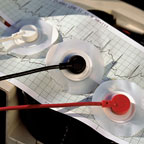
Advanced technology at Methodist is giving doctors a whole new way to look at your heart. Coronary Computed Tomography Angiography, or Coronary CTA, is a new non-invasive test that looks for fat or calcium deposits which have built up in the arteries that supply blood to the heart. The test is performed on Methodist’s ultra-fast GE LightSpeed CT scanners, which provide highly detailed images of the human body and allow for the simultaneous capture of multiple wafer-thin images of a patient’s anatomy, all within seconds.
Coronary CTA is not a heart scan, which is only used to detect calcified coronary plaque. It uses advanced 3- D imaging to look inside the heart without surgery. The exceptionally high-resolution images of Coronary CTA help physicians detect coronary artery stenosis (narrowing of the arteries) and can also detect “soft plaque” – fatty or calcium deposits that can build up in the arteries that supply blood to your heart. Untreated, this build-up can cause heart disease leading to fatigue, shortness of breath, chest pain, even a heart attack.
Methodist President and CEO Michael Bryant says, “Coronary CTA gives physicians and their patients a new, non-invasive tool for the diagnosis of heart disease. It is a fast, safe, and cost-effective alternative to traditional tests.”
Coronary CTA has been featured prominently in articles in national magazines, including Time and Newsweek. It was also the subject of a recent episode of Oprah Winfrey’s TV show. Oprah and several of her guests underwent the procedure and discussed the results on-air with a physician (Oprah’s heart checked out just fine). Locally, the test proved to be a potential lifesaver for WMBDTV news anchor Bob Larson. As part of a news story on advances in detecting heart disease, Larson – a runner who watches what he eats – opted to have a Coronary CTA. To his surprise, the test showed complete or nearly complete blockage of one artery. A follow-up stress test helped to confirm the result and Larson subsequently had two stents placed in his artery.
Coronary CTA takes about 15 minutes. The patient is given a small injection of x-ray contrast, after which they are instructed to hold a deep breath for 20-25 seconds while the CT scanner creates the images. A computer then assembles the images into a 3-D picture for the radiologist to review. Because the test is non-invasive and no sedative is required, it takes less recovery time than traditional cardiac catheterization. A physician’s order is required for Coronary CTA, which is covered by Medicare and most insurance plans.
The Coronary CTA is recommended for anyone with a family history of heart disease, current or former smokers or anyone with high blood pressure, high cholesterol or obesity. If you have any of these risk factors for heart disease, ask your doctor about a Coronary CTA. tpw
Coronary CTA is not a heart scan, which is only used to detect calcified coronary plaque. It uses advanced 3- D imaging to look inside the heart without surgery. The exceptionally high-resolution images of Coronary CTA help physicians detect coronary artery stenosis (narrowing of the arteries) and can also detect “soft plaque” – fatty or calcium deposits that can build up in the arteries that supply blood to your heart. Untreated, this build-up can cause heart disease leading to fatigue, shortness of breath, chest pain, even a heart attack.
Methodist President and CEO Michael Bryant says, “Coronary CTA gives physicians and their patients a new, non-invasive tool for the diagnosis of heart disease. It is a fast, safe, and cost-effective alternative to traditional tests.”
Coronary CTA has been featured prominently in articles in national magazines, including Time and Newsweek. It was also the subject of a recent episode of Oprah Winfrey’s TV show. Oprah and several of her guests underwent the procedure and discussed the results on-air with a physician (Oprah’s heart checked out just fine). Locally, the test proved to be a potential lifesaver for WMBDTV news anchor Bob Larson. As part of a news story on advances in detecting heart disease, Larson – a runner who watches what he eats – opted to have a Coronary CTA. To his surprise, the test showed complete or nearly complete blockage of one artery. A follow-up stress test helped to confirm the result and Larson subsequently had two stents placed in his artery.
Coronary CTA takes about 15 minutes. The patient is given a small injection of x-ray contrast, after which they are instructed to hold a deep breath for 20-25 seconds while the CT scanner creates the images. A computer then assembles the images into a 3-D picture for the radiologist to review. Because the test is non-invasive and no sedative is required, it takes less recovery time than traditional cardiac catheterization. A physician’s order is required for Coronary CTA, which is covered by Medicare and most insurance plans.
The Coronary CTA is recommended for anyone with a family history of heart disease, current or former smokers or anyone with high blood pressure, high cholesterol or obesity. If you have any of these risk factors for heart disease, ask your doctor about a Coronary CTA. tpw
